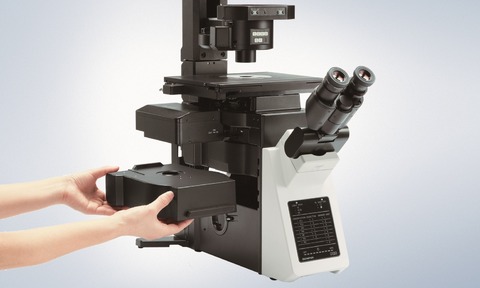Olympus’ custom creation
24 Jan 2013

Olympus’ latest IX3 inverted microscopes could pave the way for greater customisation in the laboratory.
Inverted microscopes have become a powerful tool for observing a wide range of specimens. But while their benefits are evident, historically their use has required considerable experience and knowledge, such as how to properly exchange multiple units.
In an attempt to resolve this, Olympus recently unveiled its IX3 Series of three research inverted microscopes: the IX83, IX73 and IX53 for live cell imaging.
The biggest change in the series is in the flexibility provided by opening up the light path.
This means that researchers can now tailor the configuration of the microscope to their needs, without requiring advanced knowledge.
The IX3 range features a deck system within the microscope frame to provide application-specific functions such as adding a camera or fluorescence observation.
Advanced imaging procedures are also simplified with Olympus’s cellSens imaging software, which supports a string of operating steps from image capture, measurement and image analysis through to reporting.
The aim is to provide researchers with a quick and easy work flow to reduce damage to cells during observation.
Alongside the range, five new objectives have been introduced. The APON100XHOTIRF objective- the first in the world to achieve a numerical aperture (NA) of 1.7- has been developed for total internal reflection fluorescence microscope.
There is also the UCPLFLN20XPH and three more objectives that are ideal for observing cell colonies such as iPS cells- a topic that has received increasing attention in regenerative medicine.
According to Olympus, the future in microscopy is in customisation. With applications the number of applications increasing, the IX83 could be the first in a new generation of open source, modular imaging solutions for the research community.
Q&A with Wolfgang Hempell, product manager of the IX3 series at Olympus
What is the main innovation in the IX3 range?
We’ve implemented a new access to the light path in microscopy which has never been done before. It means that researchers will be able to use new methods for exploration. With inverted microscopes, people need to document what is happening very quickly. Different adaptations are needed and by using a customisable light path, we can provide that easily without the need for major modifications.
What is unique about the IX3 series’ modular approach?
We’re leading in accessibility. Nikon have a similar way of configuring their microscope systems, but the way you change the units (like with our IX2) requires a technician to come over to do the modification. With our system you can do it yourself in less than one minute.
What was the biggest technical challenge in creating the range?
That’s tough to say. I guess the most challenging one from my point of view is opening up the parallel light path. If you compare it to the competition out there, nobody else offers this. The optical and mechanical systems have to work together smoothly. My background is optical engineering so I would say getting to that stage was the most challenging part of the project.
Where do you think the industry is heading in the next decade?
I expect a lot of close boxed systems to come on the market that will satisfy the need for high-end fluorescence imaging. With the evolution of light sources and very high sensitive cameras, I expect a lot of new applications to come from the photo manipulation area, where people are manipulating the cells and observing what is happening there.

